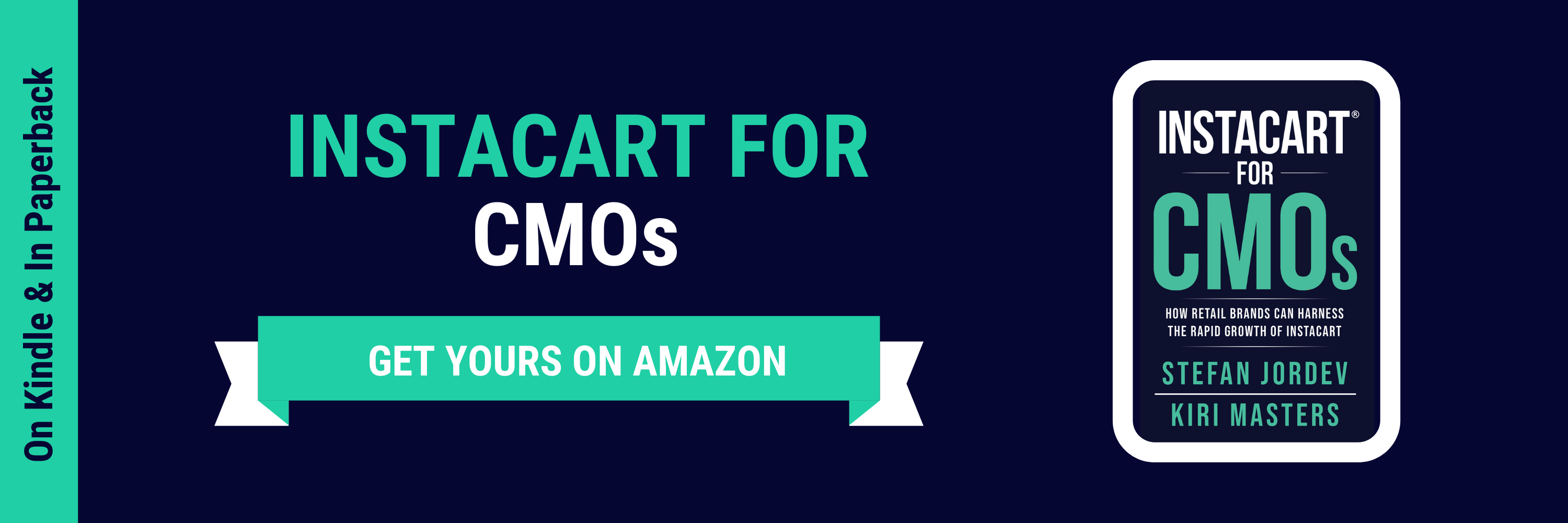Instacart differs from many other digital marketplaces because brands are unable to manage their product catalog directly. Competitors in your space with strong retailer relationships could be establishing significant market share dominance on the platform, while you sit off to the side, completely in the dark about what’s gone wrong.
The Bobsled team has been managing brands’ advertising spend on Instacart since 2020, and alongside our clients, have witnessed the staggering growth of the channel firsthand. We are bullish on the growth opportunity that Instacart presents, and summarized our strategic insights in the recently published book Instacart for CMOs.
Today’s article provides a snapshot of an important topic that we discuss in great detail within the book: in the context of Instacart, what does a successful brand and retailer relationship look like? To find out more, read on!

When it comes to success on Instacart, why do retailer relationships matter?
Most online marketplaces only have two or three sides. For example, Etsy sellers sell to Etsy buyers. Amazon customers purchase from Amazon 3P sellers or from Amazon directly.
But Instacart has four important stakeholders that interact with one other:
- The end customer, who places an order on Instacart.
- The in-store shoppers, who pick the customer’s items and deliver to their door. Shoppers may interact with customers within the app e.g. to advise of out-of-stock items and recommend replacement items.
- Advertisers, the branded manufacturers who want to get their products in front of Instacart shoppers at the point of purchase.
- Retailers, who make their product assortment available on Instacart and allow the shoppers to pick, pack and deliver from their stores.
Branded manufacturers cannot sell directly on Instacart – they rely on their network of retailer partners. Retailers are the ones who are responsible for inventory availability, pricing, and product content. Therefore, if a brand wants to get a piece of the rapidly growing Instacart pie, they need to make sure their retailer partners are playing ball.

{{cta(‘4f534b6f-a4e8-4b7d-9190-cbc541bd7580′,’justifycenter’)}}
What should brands be encouraging their
retailer partners to do?
Every CPG brand will have a slightly different perspective about how Instacart fits into their overall distribution strategy. But, at the end of the day, it’s important to remember that brands don’t choose to be on or off Instacart. Participating retailers simply send data feeds with UPCs of products being sold in their stores to Instacart, who then make those products available for sale based on the zip code of the customer.
Savvy brands have noticed Instacart’s meteoric rise, and want to be where the puck is going. Therefore, the question becomes how to use your influence as a brand to increase POs with your retail buyers.
“My advice [on how to grow market share on Instacart] would be to really understand how you can influence your retail buyer,” says Julie Liu, Shopper Marketing Manager, Omnichannel at CLIF BAR.
In a recent interview during the research for Instacart for CMOs, Liu says there is rarely a retail buyer who’s dedicated to Instacart, and that the onus might be on the brand to educate the buyer about the growth you’re seeing in online grocery, as well as Instacart’s capabilities. Some obvious things to touch on with your retailer include:
- Ensuring all valid UPCs have been uploaded to the Instacart feed
- Checking that your partners have priced your products correctly
- Checking your product content is accurate and up to date
- Ensure that there is a robust process in place for keeping your inventory levels healthy

What else can brands do to grow sales on Instacart?
It’s possible to drive more sales by utilizing Coupons, Delivery Promotions and Instacart’s Featured Products pay-per-click advertising tools. Instacart currently owns just under half of all grocery delivery sales in the US, and first-mover brands are establishing their dominance on the marketplace by harnessing these tools. 
However, if you don’t have the right operational fundamentals in place, all marketing and advertising bells and whistles become redundant.
“Everything comes back to inventory,” explains Instacart for CMOs co-author Kiri Masters. “If participating retailers aren’t stocking your products, your products won’t be available on Instacart. It’s that simple.”
“Brands should be identifying which parts of the country are most critical in terms of their Instacart play, and doing everything to get retailers in those zip codes to stock your products and upload them to Instacart. This is the low-hanging fruit. Once this has been taken care of, then you can augment sales with advertising.”
To learn more Instacart advertising check out Instacart Advertising Overview For Grocery and CPG Brands
How do retailers feel about Instacart?
In short… it’s complicated.
In Episode 178 of the Ecommerce Braintrust podcast, Karen Short, Managing Director and Senior Equity Research Analyst at Barclays, broke down the strange ‘frenemy’ relationship between Instacart and retailers. The key takeaways are as follows:
- Food retail has been a laggard in terms of ecommerce penetration and the pandemic has meaningfully accelerated that. This has only made Instacart even more important for retailers that don’t have an in-house last-mile delivery solution.
- Most retailers are very beholden to Instacart. Even though Instacart is owning more and more customer data, retailers can’t afford to give up the top line revenue that Instacart provides.
- If the in-store price equals the price on Instacart, typically that retailer is paying Instacart a percent of that total basket.
- Instacart has a leg up on a lot of the food retailers because they have a huge and diverse network of partners, and this is helping consolidate their customer base.
Learn more about Instacart & retailer relationships by listening to the podcast episode in full – What Retailers Think About Instacart (and What That Means for Brands)
Above: Ecommerce Braintrust episode with Karen Short, Managing Director and Senior Equity Research Analyst at Barclays
To summarize; large retailers will eventually start rolling out their own in-house online grocery solutions, but for now, leaning heavily on Instacart’s infrastructure and customer base is a necessary evil. Brands looking to tap into Instacart’s customer base may need to coach their retail partners about how to best position themselves on the channel.
NEED HELP MANAGING INSTACART?
Book a free consultation with the Bobsled team.
{{cta(‘0825dfed-dfd0-4c96-bfc0-9b14009fed23′,’justifycenter’)}}

